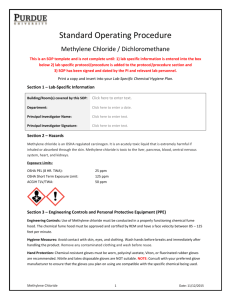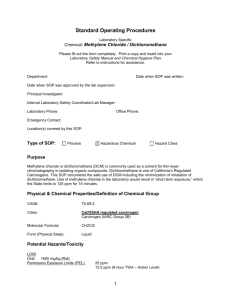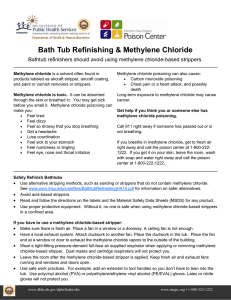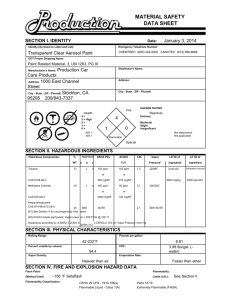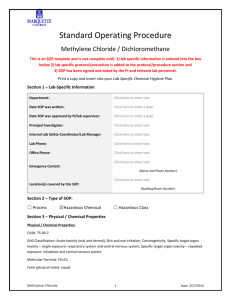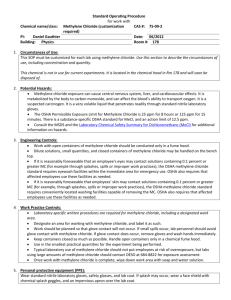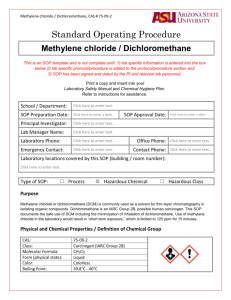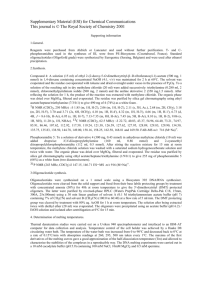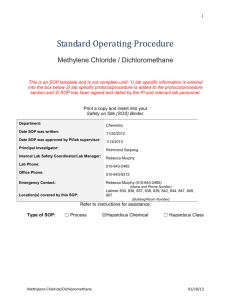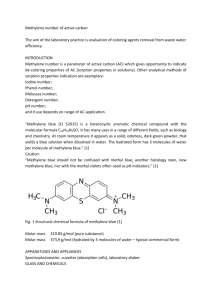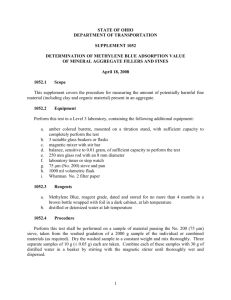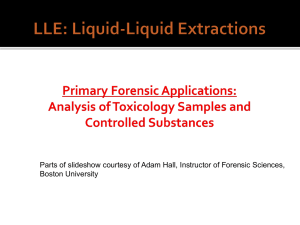Handling Methylene Chloride
advertisement
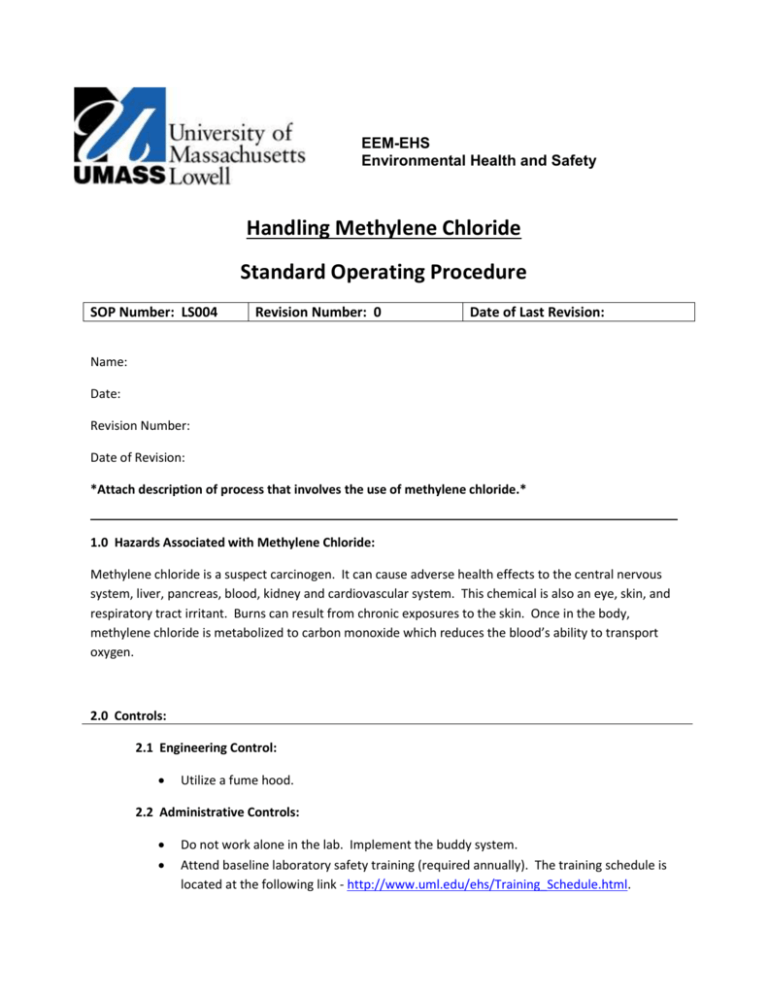
EEM-EHS Environmental Health and Safety Handling Methylene Chloride Standard Operating Procedure SOP Number: LS004 Revision Number: 0 Date of Last Revision: Name: Date: Revision Number: Date of Revision: *Attach description of process that involves the use of methylene chloride.* 1.0 Hazards Associated with Methylene Chloride: Methylene chloride is a suspect carcinogen. It can cause adverse health effects to the central nervous system, liver, pancreas, blood, kidney and cardiovascular system. This chemical is also an eye, skin, and respiratory tract irritant. Burns can result from chronic exposures to the skin. Once in the body, methylene chloride is metabolized to carbon monoxide which reduces the blood’s ability to transport oxygen. 2.0 Controls: 2.1 Engineering Control: Utilize a fume hood. 2.2 Administrative Controls: Do not work alone in the lab. Implement the buddy system. Attend baseline laboratory safety training (required annually). The training schedule is located at the following link - http://www.uml.edu/ehs/Training_Schedule.html. Attend laboratory-specific training on handling methylene chloride. o Document this training in section 8 of the Chemical Hygiene Plan Notebook. Know the location of the emergency shower and eyewash station. Review this SOP and applicable safety data sheets as part of your laboratory-specific training on handling methylene chloride. Keep a hard copy of the safety data sheet (SDS) for methylene chloride in section 6 of the CHP Notebook. Place the methylene chloride SOP in section 7 of the CHP Notebook. Purchase only enough material needed to complete an experiment. Wash hands thoroughly with soap and water after removing gloves. If gloves become contaminated with methylene chloride, remove gloves immediately and wash hands with soap and water for 15 minutes. Check hands for any signs of contamination. Launder lab coats on a periodic basis. (Lab coats that are dropped off for cleaning in the lab coat room are picked up on Monday mornings by the lab coat company and the clean lab coat is delivered to the lab coat room the following Monday. Go to http://www.uml.edu/EEM/Programs/Lab-Safety.aspx and click on lab coat program for more information.) 2.3 Personal Protective Equipment: Safety goggles are required if there is a splash hazard. Safety glasses are required at a minimum. Face shield is required if there is a splash hazard to the face. Laboratory coat Chemical-resistant apron should be worn if using large quantities of methylene chloride. Medium to heavy weight Viton ®, polyethylene vinyl alcohol, SilverShield or neoprene gloves. (Refer to a glove compatibility chart and/or contact Kathi Lyon at extension 42746.) o NOTE: Gloves must be selected on the basis of their chemical resistance to the material(s) being handled, their suitability for the procedures being conducted as well as temperature extremes. Improper selection may result in permeation of the chemical through the glove and possible personal exposure to the chemical. Closed toe shoes and pants 3.0 Precautions: Avoid contact with eyes and skin. Avoid inhalation of vapor or mist. 4.0 Storage: Store in a well-ventilated location. Heat sensitive. 5.0 Disposal: Place the UMass Lowell Hazardous Waste Label on the container and fill out the label. Full and/or dated containers of hazardous waste are picked up by EEM-EHS during the weekly inspection checks for satellite accumulation areas or upon request by calling 42543. Remember, the container must be picked up within 3 days after the container is full or dated. Since weekly inspection checks occur every Wednesday, please call extension 42543 for a pick-up if your full and/or dated container of hazardous waste is generated on a Thursday, Friday, or Saturday. Empty containers that once contained methylene chloride must be disposed of as hazardous waste. Please properly label the empty container with a hazardous waste label. NOTE: Gloves that are not contaminated with methylene chloride may be disposed of in the trash. Gloves, KimWipes, and other solid waste contaminated with methylene chloride must be disposed of as hazardous waste. Please place contaminated solid waste in an impervious, properly labeled container. Contact the chemical receiving stockroom at extension 42543 if in need of a waste container. 6.0 Emergency Procedures: 6.1 Spills For spills that occur inside of a fume hood (< 100 milliliters) If lab group has received proper training and a proper spill kit is available, the spill may be cleaned up by the lab group. If the lab group has not received proper training and a spill kit is not available, please contact EEM-EHS at extension 2618. For spills that occur outside of a fume hood Evacuate the lab, post a restriction on the lab door and call UMass Lowell Police at extension 44911. Stay close by to answer questions when EEM-EHS and emergency response personnel arrive. 6.2 First Aid For eyes Irrigate the eyes for 15 minutes, holding eyelids apart. Call extension 44911 or 978-934-4911 from a cell phone to seek medical assistance and then can keep track of the length of time eyes are being irrigated. For skin For full body exposure, remove contaminated clothing and go under the emergency shower for 15 minutes. If bare hands and/or arms are contaminated, rinse area with soap and water for 15 minutes. Call extension 44911 or 978-934-4911 from your cell phone immediately to seek medical assistance. For inhalation Remove to fresh air. Seek medical attention immediately. Call extension 44911 or 978-934-4911 from a cell phone. 6.3 Fire: Evacuate the lab, pull the nearest fire alarm pull station and then go to a safe area and call extension 44911 or 978-934-4911 from a cell phone. Follow the fire safety evacuation plan. NOTE: All work-related injuries must be reported immediately to Human Resources (HR) by calling extension 43560. (HR has some forms that will need to be filled out within 48 hours after the incident.) An Incident/Injury Report Form must be filled out and faxed to EEM-EHS at 978-934-4018. [The Incident/Injury Report Form is available on-line at http://www.uml.edu/ehs. Please double click on the link, under quick links, for permits and forms.] *The buddy, supervisor, or Principal Investigator may fill out the Incident/Injury Report Form while the injured employee follows first aid procedures and seeks medical attention.
